Everything You Need To Know About Part Exchange And The March Plate Change
As we begin a new year, many of us will start to think about getting a new car. In fact, one of the most popular periods when most cars are bought and sold happens in spring time, and there’s a big reason for this. The March Plate Change!
In this article we’ll discuss everything you need to know about the March plate change, including whether you’re better off acquiring a new car before or after the update, as well as all the most important information regarding part exchange, as many will see this as their best option, thanks to its ease.
Everything You Need To Know Before Part Exchanging Your Car
What Does Part Exchange Mean?
Part exchanging your car means that you trade in your old car to help reduce the cost of a new one. The value of your old car is calculated by the company offering the part exchange scheme and then they reduce the cost of your new car by how much your old car is worth.
Millions of drivers opt for this scheme as it can save you money and is normally far easier than selling your old car privately, outright to a dealer or at an auction.
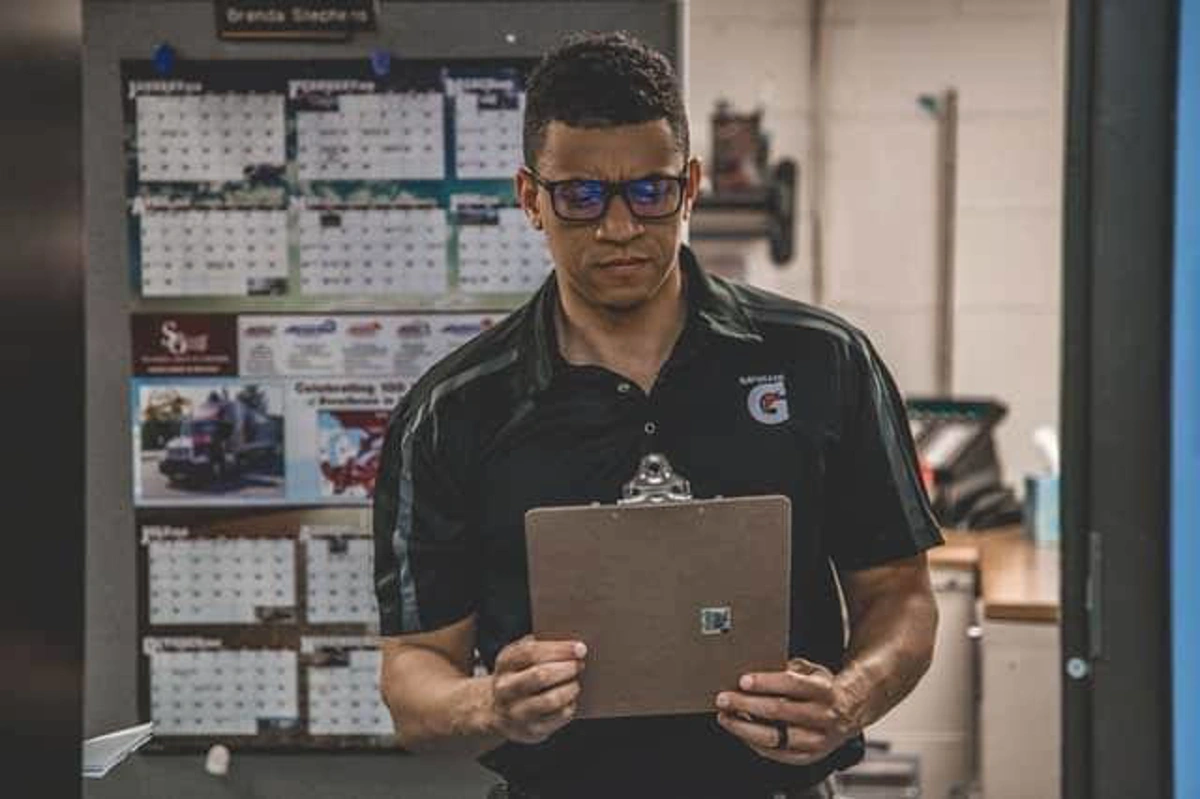
The Part Exchange Checklist
10 Things You’ll Need To Part Exchange Your Car And Why
Here’s everything that the company you’re part exchanging with will ask you for during the process;
1. The Car
We start with the obvious, you’ll need the car. A no brainer, obviously, however you may not realise that there are a few things you can do to your car before part exchanging that will help you increase its value. Read on to discover.
2. All Keys + Spares
Once you’ve got the car, you’ll need the key to get into it. If you don’t, not only are you going to look very suspicious, but it’ll also decrease the value by £250, as a new key will need to be sourced.
3. Alloy wheel unlocking keys/tool
Similarly to the keys, having the make and models’ correct alloy wheel unlocking key (also known as ‘locking wheels nut’) and/or tools is another headache that a new owner doesn’t want to think about, especially when it’s one that could be essential if a new tyre needs fitting at the side of a road should a freak puncture occur.
4. Owners Manual
Having the original owners manual is an important document to hand over in the part exchange process and it’s vital that new owners have something that explains everything about the car they’ve just received, such as the dashboard, entertainment console and any alarms or locking systems etc.
Nowadays, a lot of the information in these booklets is available online but it gives the new owner some peace of mind to have the paper version handy, especially if you break down in the middle of nowhere.
5. Logbook (V5C)
The Car’s V5C, also known as its ‘logbook’, shows potential buyers that you are the registered keeper and when it was first registered.
It also houses information such as the number of previous owners the vehicle had before you and other factors that confirm the car is as described, like the engine size, original colour, number of doors and the vehicle identification number (VIN).
If any modifications have been made to the vehicle, these should be listed on the V5C.
6. Original Purchase Receipt
If your current car was a purchase rather than a car lease, it’s likely that you were given a receipt of purchase. Having this is beneficial during a part exchange, not only because it confirms you were the buyer, but also because it’ll have details important to the part exchange company, such as the date you bought the vehicle, its mileage and the price you bought it for.
7. MOT Certificates
The law states that your vehicle must have a valid MOT certificate once it’s over three years old. Having one, and being up-to-date, is very important, as the more recent your MOT certificate is, the more assured the part exchange company will be that the vehicle is running at optimal performance.
It’s also vital that you can provide a history of MOT certificates as it shows the vehicle was well taken care of while in your ownership and also any advisories that were identified at the time.
8. Service History Handbook
Equally important to the MOT certificates is the service history. This will have stamps from an authorised dealer or approved garage showing your vehicle has been properly maintained at regular intervals, again promoting that the vehicle has been thoroughly looked after.
If work has needed to be carried out on your vehicle, which is completely normal for some older cars, make sure to provide any receipts showing when work was carried out on fixes and advisories, plus the cost. This is the same for any ad-hoc or emergency repairs, such as new tyres, wheels, windscreens and wipers.
If you’ll be taking out finance, you’ll also need the following:
9. Identification
As with many high-cost purchases and/or sales, proof of identification is needed to make sure you are who you say you are.
10. A bank statement or utility bill (less than 90 days old)
When going through a finance deal, part exchange companies may also require a recent bank statement or utility bill.
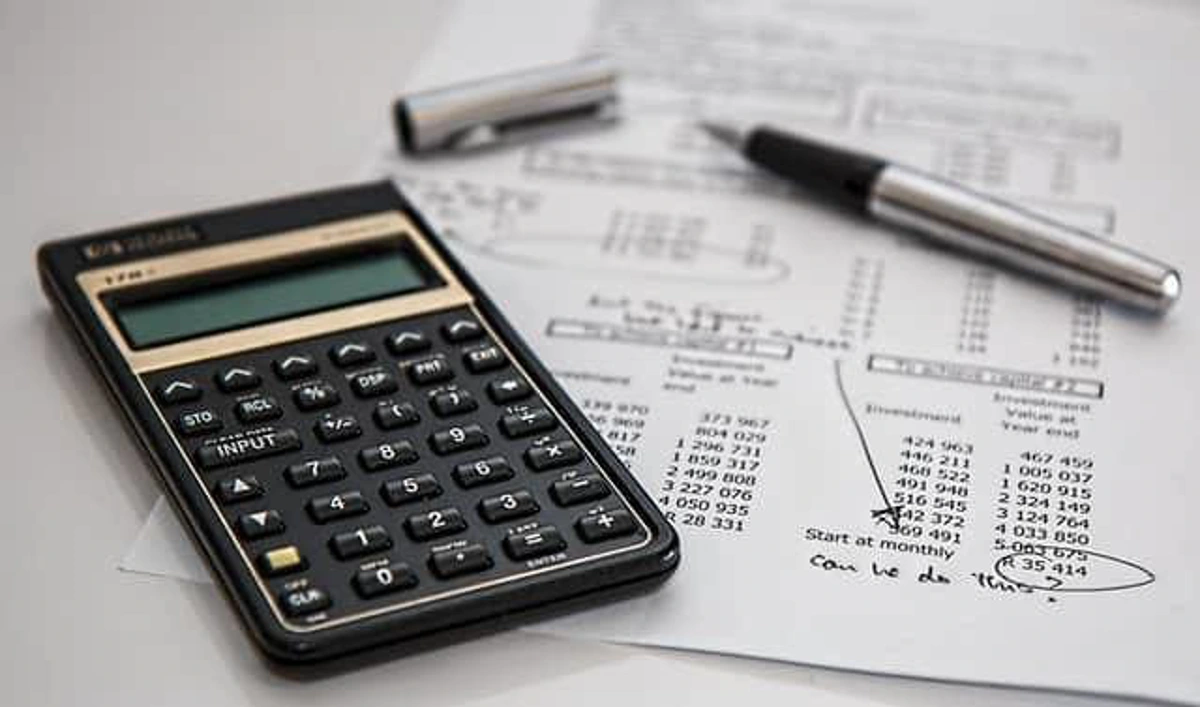
8 Key Elements That Go Into Car Valuations
During car valuations, multiple checks are made to provide the most accurate quote possible for the car you are part exchanging. Here are eight key factors companies take into account;
1. Mileage
The average annual car mileage in the UK can fluctuate year to year and if your car has exceeded the average, you can expect to see a decrease in your vehicle’s value as it may end up in a higher mileage band than others. Each time a car passes through a band, it will lose an average of 20% of its current value.
This means if you’re looking to part ways through part exchanging, keep the miles to a minimum.
2. Standard Equipment And Modifications
When part exchanging your car, it’s beneficial to restore it to its former self, especially if you’ve modified it at all. Modifications can severely decrease the value of your car, so before anything else, make sure to replace any mods with original parts.
3. Condition
The more a car looks and functions as good as new the more likely it will hold more of its value. Any dents or scratches can lead to heavy decreases in value so make sure to buff out anything you can remove yourself before putting your car on the market.
4. Colour
Yes colour does make a difference. If your car is in a shade that’s popular, such as white, black, red or blue, it will hold its value more than a car that’s been given a lovely neon green makeover.
5. Make, Model & Spec
Some cars are more desirable than others. That’s just the way things go. Similarly to colours, if you’re part exchanging a car that’s of a popular make or model, such as a Ford Focus or a Seat Leon, they tend to hold their value more as more people are interested in attaining them.
The specification of your car will also factor into its value. For example you will have two very different valuations when you compare a standard Volkswagen Golf to the GTI and other performance models.
6. Service History
If you can prove that your car has been thoroughly looked after this will help boost its value. You can do this by providing MOT certificates and a full service history when submitting paperwork to the company you’re part exchanging with.
7. Location
Depending on what type of car you own, it may be affected by where you are located. For example, you may be able to achieve a higher value for a 4X4 in more rural locations, while a small hatchback may find added value in more urban environments.
8. Timing
You should also think about what time of year is most suitable to part ways with your car, especially if it’s suited for certain seasons. For example, cabriolets will perform better in warmer months, while big off road vehicles will gain more interest in the winter months.
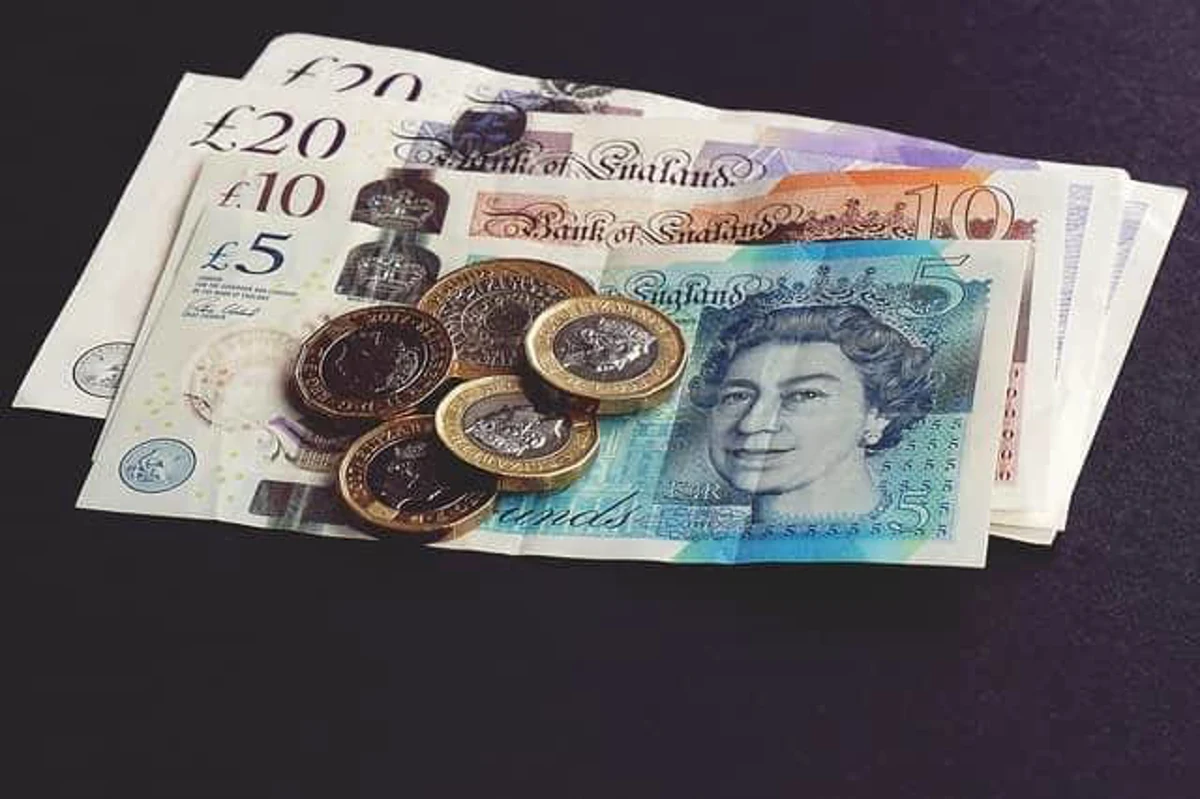
4 Value Boosters When Part Exchanging Your Car
Including one tip that could add over £900 to your car’s value!
If you’re thinking of part exchanging your car, there are a few things you can do that will help boost the value of your vehicle.
1. Mechanical Makeover
You need to make sure that your car is in full working order and running to the best of its ability, no matter its age. Here’s a quick list of things to do before you look to part exchange your vehicle;
- MOT / Service
If your car hasn’t had an MOT or service recently and is due one in the near future, make sure to do it before part exchanging. Many believe that getting rid of a car before doing these makes life easier, but in reality all you’re doing is removing value from the car, as new owners and/or part exchange companies will need to get these done before driving your vehicle.
- Warning Lights
Make sure there are no warning lights flashing up on the dashboard. If there are, again, make sure to sort these before part exchanging.
- In-Car Entertainment And Electricals
Is everything on the inside of your car working properly? Double check to make sure fans, radios, seats, buttons and levers are working as they should. If not, fix before selling.
2. Paperwork Prep
There are various bits of paperwork you’ll need when part exchanging or selling your car. Here’s a list of everything you’ll need;
- Logbook (V5C)
- Owners Manual
- Service History
- MOT Certificate/s
- Original Purchase Receipt
- Identification (Passport/Driving Licence)
We’ve gone into more detail regarding these in The Part Exchange Checklist.
3. Picture Perfect Photography
A vital part of selling your car, especially if you’re doing so privately, is to take lots of high-quality photos of your vehicle. Here’s a few tips to make your car stand out above the rest;
- Take pictures from all angles, both inside and out.
People want to see everything to make sure there’s no dents in the bodywork or scratches on the interior plastics. The more pictures the better.
- Don’t Forget Videos
Once you’ve taken a bunch of great photos, why not take a few videos too? Do a walkaround of the car and also a full 360 degree shot of the interior.
- Try and take pictures on a nice day.
A gloomy setting can reflect badly on your car so try and take your pictures on a nice, sunny day. (Tough in the UK, we know).
- Car Positioning
Position your car away from busy backgrounds and away from overhanging trees and/or buildings to reduce shadows.
- Show that everything works.
Through pictures and videos, show that all lights inside and out are working. Show that there are no warning lights on the dashboard and that the entertainment centre/centre console is in full working order.
- Quality & Quantity
While taking a lot of pictures is beneficial, they need to be of high quality to entice a new buyer and make your car appear the best it can. Use the most high quality camera available to you. Smartphone cameras are great and will do the job but, if you want the best quality, if you have access to a proper digital single-lens reflex (DSLR) camera, use that instead.
4. A Thorough Cleanse
A thorough cleanse inside and out is one of the most simple and important ways to improve the value of your vehicle. Make a note to remember to clean the inside of the windscreen, vacuum the floor and remove any strains from the seats.
On the inside make sure to remove anything that didn’t come as standard, here’s a list of common examples;
- Changing wires and docks
- Third party SATNAV systems
- Baby/Child Seats
- All junk and/rubbish like receipts and sweet wrappers.
- Spare change from the centre console
- Cleaning cloths and sprays
On the outside, all you need to do is to give your car a really good wash. According to a recent report, you can boost the value of your car by a massive 10% just by giving your car a thorough clean.
If you combine this with nimblefins.co.uk’s research into used car prices, which states that the most popular used vehicle price range as of October 2020 was between £9,000-£10,000, that means you could increase your car’s value by £900+, just from cleaning it properly!
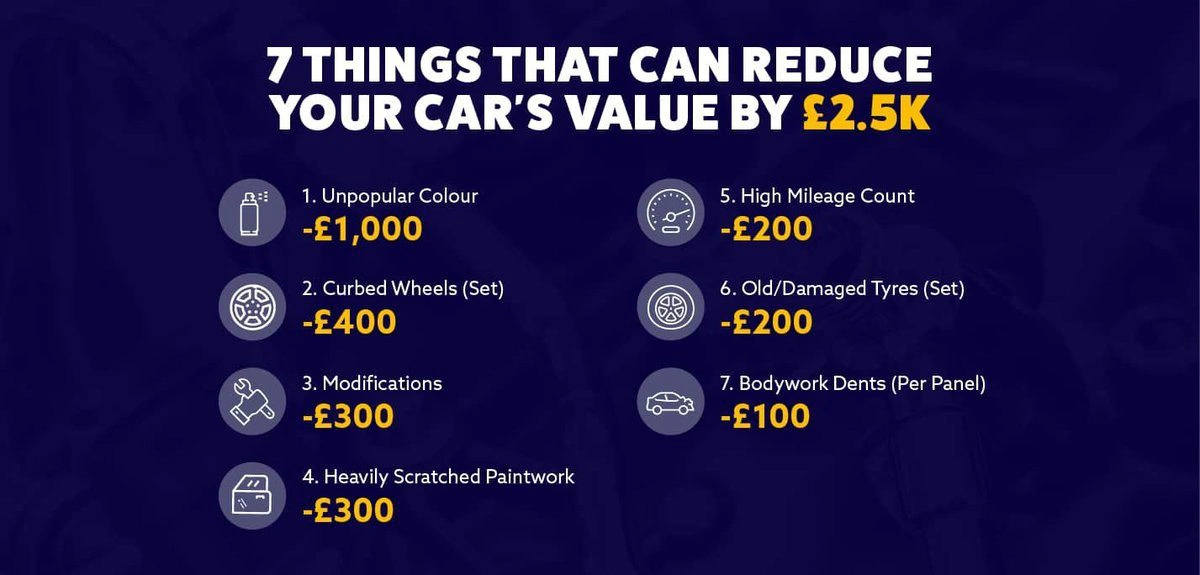
7 Things That Can Reduce Your Car’s Value By £2.5k!
It’s important to look after your car both inside and out. Doing so will make it last longer and, when it comes round to wanting to sell or part exchange it, prevent its value from dropping as much as possible. Here are a few tips that can boost the value of your car simply using a bit of TLC.
1. The Colour Of Money - IS NOT PINK!
Just ask Katie Price. A few years ago, the former model and i’m a celeb star sold her Range Rover but due to asking for it in pink, the resale value dropped by £3,000. Now, of course, not everybody is lucky enough to be able to reap the rewards of cashing in a Range Rover, so does colour impact the cost on any vehicle. The answer is yes.
According to a report on thisismoney.co.uk you expect to receive between £500-£1,000 more if the car is coloured in a popular coat of white or silver compared to the more unfavourable dark greens and browns.
2. Stay Away From The Curbs (£400)
Curbs are the kryptonite to our wheels, so at all possible times, stay away! When you hit a curb, not only will it scratch and/or dent your alloy wheels but it will leave a big hole in your pocket following a hefty bill. If you leave them dinged and dented when trying to part exchange your car, you could be devaluing your car by as much as £400, as curbed wheels cost around £100 to repair, each.
3. Nightmare Modifications
There’s a lot of talk about whether or not modification can add or reduce part exchange value. Most of the time, it decreases it. Recent research has highlighted some of the most harmful modifications you can make to your car and how much they decrease its value;
1. Negative camber wheels = -£310.71
2. Vehicle Lowering = -£286.29
3. Modified Exhaust = -£239.08
4. Racing Seats = -£187.33
4. Buff Out Those Scratches And Scrapes! (£300)
We all get scratches and scrapes on our cars, it’s unavoidable thanks to debris on the roads, things falling out of trees etc, but it’s important to keep on top of your car's paintwork. For the majority, a good ol’ polish will do the trick, but if you leave it and attempt to part exchange the vehicle in its current condition, you could lose a few hundred pounds off your vehicle’s value.
5. Mileage Makes a Difference (£200+)
In today’s world, as an average, we expect cars to rack up around 10,000 miles per year. That’s why you usually see this figure when you’re looking at the financial elements of attaining a new car. Unfortunately, as a rule of thumb, if you’re doing a lot more than that, according to buymycar.com you can expect hundreds of pounds to be knocked off the price.
6. Tread Carefully With Tyres (£200)
Tyres are all that’s between you and the road and is one of the most important elements of a car when it comes to safety. So, keep an eye on them and as soon as the tread gets too low or you see sidewall damage, switch them out for a fresh set. If you don’t and you part exchange your vehicle when the tyres are in bad shape, the cost of repair will be knocked off the car’s value, which could cause a decrease of over £200.
7. Ditch The Dents (£100)
Similarly to scratches and scrapes, leftover dents in your car’s bodywork will also decrease its value. You could potentially lose £50-£100 per panel if repairs are needed. While dents in the bodywork may not seem like a big deal, they can actually hamper the car’s structure and may cause it to act improperly if an accident occurs.
Guide To The March Plate Change
What Is The March Plate Change?
The March plate change is one of two annual dates where car number plates are updated. These happen on the 1st of March and the 1st of September.
How Do Plates Change When They Are Updated?
In March, you’ll see the number ‘21’ introduced, signifying that the car was newly purchased between March 1st - August 31st 2021. In September, the ‘21’ will become ‘71’ as the number is increased by 50 to show the car was purchased in the second half of the motoring year, between September 1st and the end of February of the next year.
Registration Plates are split up into three sections, the Local Memory Tag, the Age Identifier and the final Random Element to complete the plate.
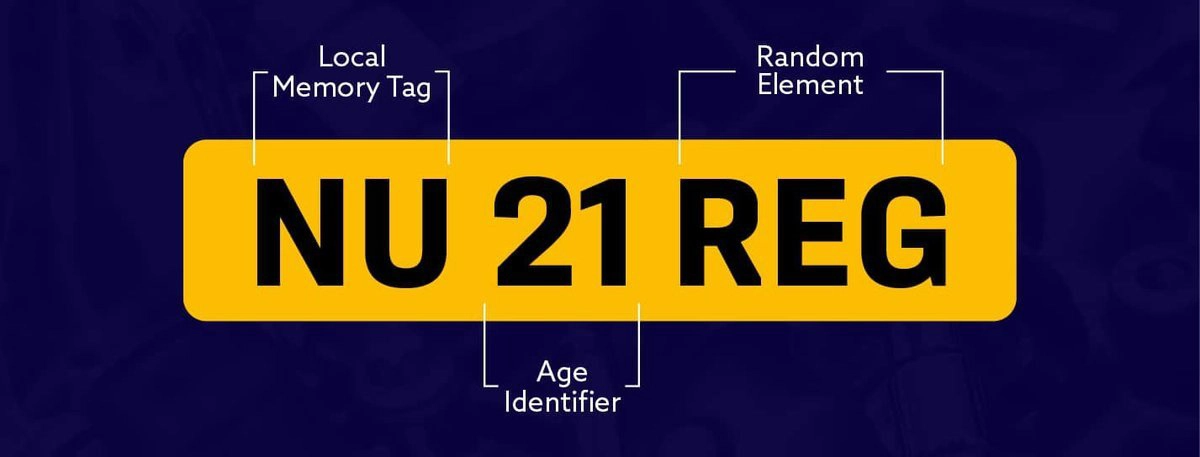
Local Memory Tag
The first two letters represent where a vehicle has been registered, known as the Local Memory Tag, and the letters will change depending on different regions across the country. For example, the letters MA – MY cover the Manchester and Merseyside regions, whilst LA to LY letters represent London.
Age Identifier
The Age Identifier represents the two numbers found on a registration plate and are the ones that signify the age of the car. These change every six months in March, showing the year (21, 22, 23 etc) and September showing the year plus 50 (71, 72, 73 etc), showing it was registered in the second half of the year.
For example, if a vehicle is registered in March, it may have a plate showing NA21 YRG. If it was registered after September, it would be updated to NA71 YRG. The vehicle was registered in the same year, just six months later.
Random Element
The final three digits are randomly generated and allocated to different vehicles to make sure each is unique.
Private Plates
It’s worth mentioning that private and/or personalised registration plates may not follow this criteria. With private plates it’s important to note that your car must be newer than the plate itself. You are not allowed to make your car appear newer than it is. For example, if your car was on a 61 plate, you could not therefore replace it showing 12 or higher.
Why Are Plates Changed In March And September Of Each Year?
Vehicle registration plates are updated on the 1st of March and 1st of September every year, via an “Age Identifier registration prefix”. These updates help to identify the age of a car, as it signifies when a vehicle was registered, allowing you to calculate how old or new it is. From a manufacturers’ perspective, updating the plates every six months, rather than once a year, helps spread sales throughout the year, rather than have a huge surge in car registrations all at one time around August, which is how it was prior to the registration plate change in 1999.
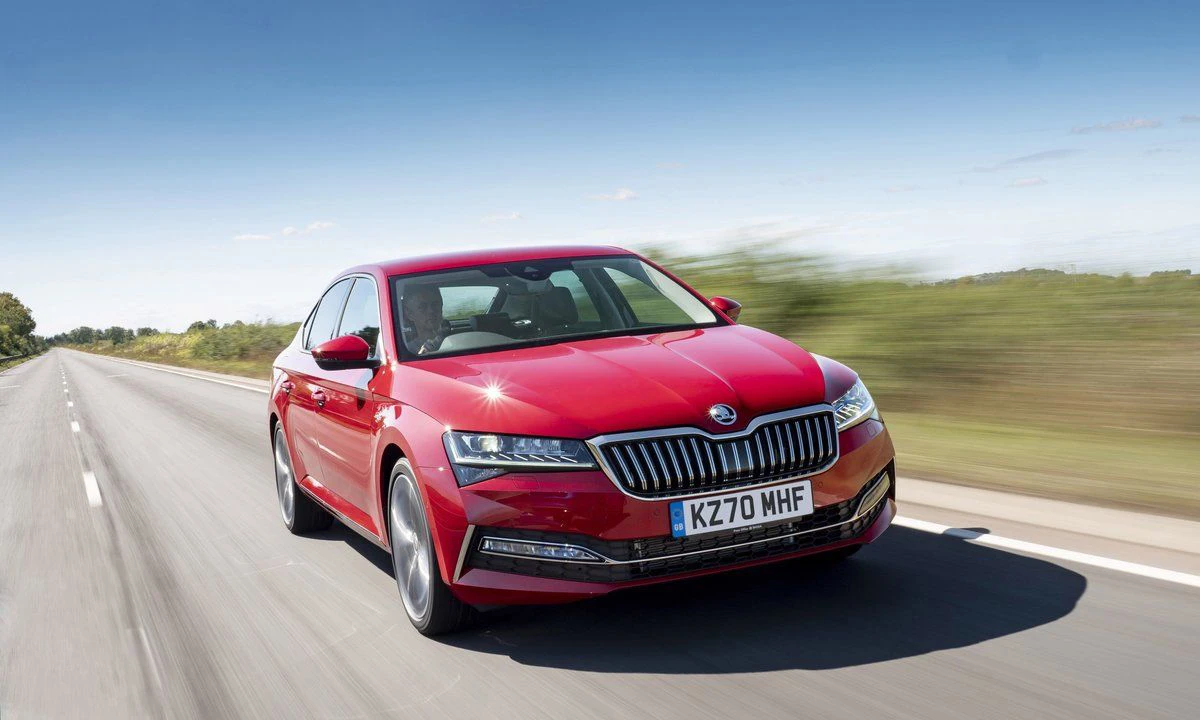
How To Tell How Old Your Car Is By Its Registration Plate
You can tell how old your car is by referring to its registration plate. To do this you need to refer to the numbers on your plate. Once you’ve found the numbers, you’ll see either the year it was registered (18, 29, 20 etc) or the year it was registered plus 50 (68, 69, 70 etc). If your car has the number of the year it was purchased, this shows you that it was registered between March and the end of September, if it’s the year plus 50, it will have been registered between August and the end of February the following year.
Should I Get A New Car Before Or After March?
This depends if it is important to you to have the latest registration plate or not. If you want a new car with the latest registration attached to the vehicle then you should wait for March. However if having the latest registration plate isn’t as important to you, then opting for a new car earlier could be a good option as you’ll find a lot of great deals just before the plates are changed.




